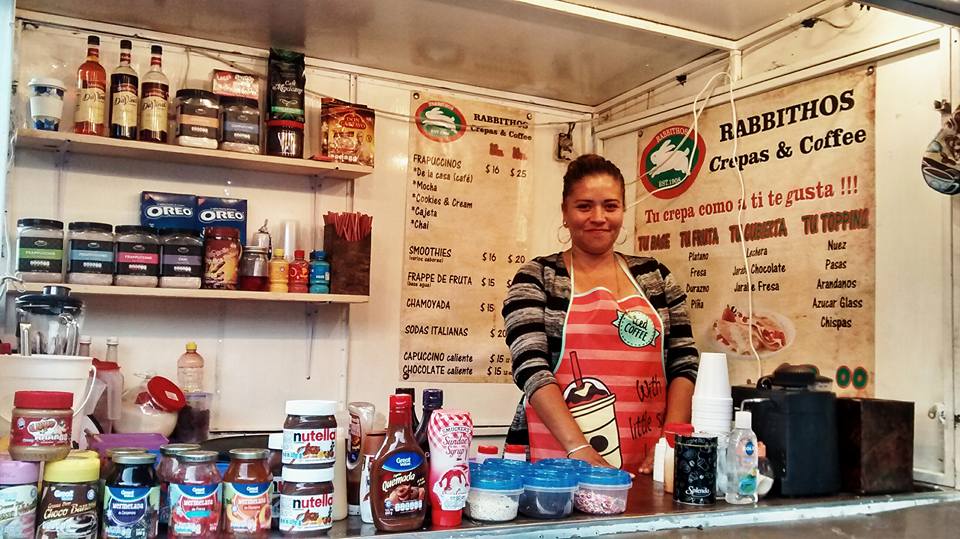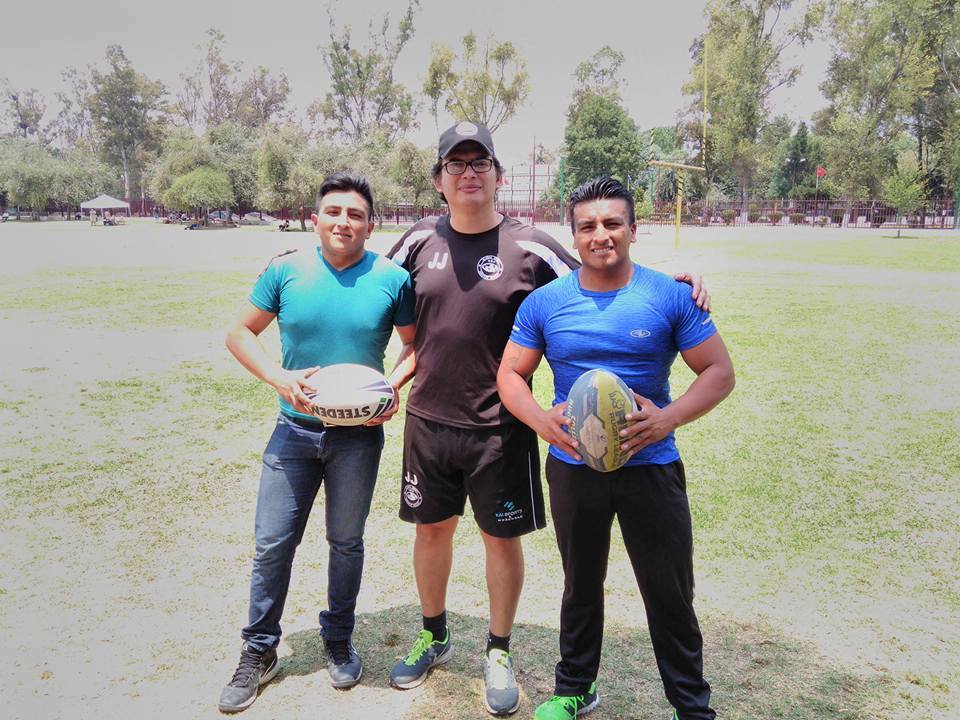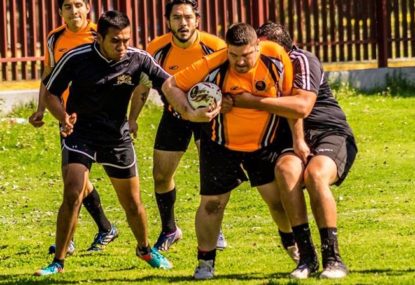A significant venture into international territory by rugby league almost went undocumented in the lead-up to last weekend’s fantastic representative round.
For the first time, the Asia Pacific Rugby League Confederation – a key branch of the Rugby League International Federation – partly funded a development expedition to Mexico.
Before I get shouted down by the sceptics, the tweed patch brigade, and those who believe everything that happens outside Australian shores is irrelevant, I’ll give you 10 good reasons why this is a cracking sports yarn – regardless of your views on rugby league as a global sport.
1. There’s already a Mexican Cafe named after the Bunnies
That’s right, to the north of the capital Mexico City is a vendor called Rabbithos Crepas and Café.
Whether the spelling error in Rabbitohs is intentional or not to discourage accusations of trademark infringement I’m not sure, but it was definitely inspired by one of Australian rugby league’s foundation clubs.
On the menu you’ll find a white bunny on a green oval, bordered by a red outline which bears a likeness to South Sydney’s club logo.
Even better, you can buy a cappuccino or smoothie for the equivalent of A$1. True battler prices!
The café was started by Carlos Munguia, a diehard Bunnies and Sam Burgess fan who helped found the establishment of Mexico’s domestic competition.
And no doubt, the café plays a central role in keeping rugby league humming along locally.

(Mexican Rugby League)
2. A sibling rivalry for the ages
Brotherly rivalry has given us some great narratives over the years, from the Gallaghers to the Milibands, to Loki and Thor, and even Scar and Mufasa.
While Carlos Munguia may be an ardent Rabbitohs fan, brother and co-founder Ruben is a mad Canterbury Bulldogs fan – and it is arguably this passionate rivalry between two key officials of Mexico Rugby League which has led to the sustained presence of the sport.
In the lead-up to clashes between Souths and Canterbury, the two will openly bait each other on social media… and it gets fierce.
Those two clubs being pitted against each other in the 2014 grand final only added accelerant to the fire, and inadvertently may have been one of the best things to happen for the promotion of the NRL on foreign soil.

(Mexican Rugby League)
3. Give me a sense of scale
Take all the nations involved in the Pacific Test Invitational – England, PNG, Fiji, Samoa, Tonga and the Cook Islands – and you have a combined population of 62 million.
Add in the nations that contested the Phoenician Cup on the same weekend – Lebanon and Malta – and there’s another 7 million.
Throw in trans-Tasman combatants Australia and New Zealand for an extra 28 million and now we’re talking about countries representing 97 million people being engaged last weekend (note, pedants, I’m not claiming every individual was engaged).
If we draw a long bow and say that the Toronto Wolfpack’s landmark game meant we should count the Canadian population, there’s another 36 million people for a grand total of 133 million folks.
The population of Mexico is only slightly less than all the above combined at 127 million. The greater municipal district of Mexico City has 21 million people alone and a density of 8,400 people per square kilometre.
4. Rugby League has been played in Mexico how long?
Believe it or not, Mexican rugby league already has its own historian, Guillermo Ruiz Buenrostro, a science fiction and popular culture buff with long hair and a big bushy beard.
A university lecturer, Ruiz Buenrostro has almost single-handedly driven rugby league’s presence in Guadalajara, 540km north-west of Mexico City.
He maintains there are tales of rugby league being played predominantly between English expats in the Mexican oil industry in the 1930s, shortly before the Second World War. However there is no documentation to confirm this.
More recently, rugby league seems to have surfaced in 1998 via occasional exhibition games mainly tied to different universities and colleges.
In terms of regular, seasonal tournaments or fixtures, Mexican rugby league really kicked off in 2013.
Mexico has the longest-running consecutive competition in any Latin American nation, including Argentina.
5. They also have their own Origin competition
The best way to think of the structure of Mexican rugby league is to think of the way the NSWRL and QRL previously operated.
There are two separate bodies that control the sport domestically, but they work in tandem.
There is the MRL operated by the Munguia brothers in the capital and Rugby League Jalisco operated by Ruiz Buenrostro and allies in the country’s mid-west, incorporating players from five adjoined states.
Each year they play a ‘Copa Origenes’ fixture under the broader regional banners of Valle de Mexico (MRL) and Occidente (RLJ).
Last year was the first time the ‘boys from the bush’ have ever won, with Occidente scoring a 56-0 victory on home soil. Not a bad way to notch your first win.
6. Visa issues have meant a lack of international opposition
Until now the missing link in further growth of rugby league in Mexico had been the absence of international collaboration. Essentially Mexico has been an island in the sport.
Attempts to get Mexican players to feature at last year’s Philadelphia Nines were stonewalled by a visa application situation that was both expensive and unfavourable.
Additionally, such are the distances involved and the poor funding of rugby league in nearby nations such as the USA and Jamaica, it’s not been easy to get teams to travel inbound.
And unfortunately, many have succumbed to fear-mongering about the risks in travelling to Mexico.
7. Until along came Super Juan
The man to break the impasse has been English-based rugby league development enthusiast Juan Jasso.
He’s a former US serviceman who is part Mexican, part Native American Indian, part Spanish and previously worked with the London Broncos as a scholarship coach.
He’s believed to be the highest accredited Latino rugby league coach in the world and has also worked with Latino communities in the USA and Argentina, as well as the Global Rugby League Academy.
Jasso received worldwide renown last year when he stood up to racist thugs on a Manchester tram at the height of Brexit angst, earning him the nickname ‘Super Juan’.

(Mexican Rugby League)
8. By holy decree?
Jasso achieved a heck of a lot during two short weeks in the Mexican capital, including not only conducting skills clinics for players and recording instructional videos in Spanish, but also mapping out player pathways, accreditation systems, schools modules and a bolstered business plan for Mexico Rugby League.
He was pleased to report back about new sponsorships and partnerships, and the acquisition of a regular training field – something often difficult to attain in developing nations.
As it so happened, when he and Carlos Munguia attended church together one morning they found a section dedicated to the life of 16th Century saint Francis Xavier.
The dedication revealed the name of St Francis Xavier’s father was, in fact, Juan de Jasso!
9. The mystery of Texan rugby league
The modern day Juan Jasso was raised in Brownsville, Texas, which sits astride the USA’s border with Mexico.
One of the most exciting, but mysterious, advents in recent rugby league times has been the emergence (and disappearance) of the Texas Rugby League Association, which promised to include the San Antonio Coyotes, Dallas Dragons, Austin Cowboys and Houston Seahawks.
The TRLA gained a lot of interest when it was first floated on social media a few months back, including from Jasso and other expansionists who saw it as a way of finally linking both sides of the Rio Grande.
However TRLA accounts have since been deleted and it’s fallen silent.
Both Texas and California have the potential to change not only the USARL, but also impact the global spread of rugby league if they can be harvested in a sustainable way.
10. The next step
Like all competitions in their formative stage, the priority for Mexico is looking after their own backyard and making sure their domestic clubs survive.
Certainly they have some of the best club names in rugby league – including the Spartans, Silverbacks, Direwolves and Grizzlies.
However only around six clubs are consistently playing on a seasonal basis, with others dropping in and out.
In that respect, it’s actually not too different to how league started in Australia (Cumberland, Newcastle Rebels anybody?).
Beyond that, Mexico is hopeful of being among the participants in an inaugural Latin American Rugby League Championship, slated for Santiago, Chile on November 18-19.
































































































